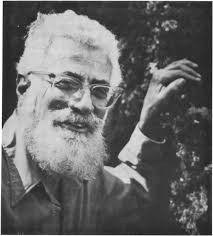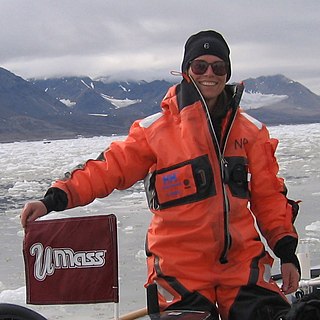Related Research Articles

Creation science or scientific creationism is a pseudoscientific form of Young Earth creationism which claims to offer scientific arguments for certain literalist and inerrantist interpretations of the Bible. It is often presented without overt faith-based language, but instead relies on reinterpreting scientific results to argue that various myths in the Book of Genesis and other select biblical passages are scientifically valid. The most commonly advanced ideas of creation science include special creation based on the Genesis creation narrative and flood geology based on the Genesis flood narrative. Creationists also claim they can disprove or reexplain a variety of scientific facts, theories and paradigms of geology, cosmology, biological evolution, archaeology, history, and linguistics using creation science. Creation science was foundational to intelligent design.

A volcanologist, or volcano scientist, is a geologist who focuses on understanding the formation and eruptive activity of volcanoes. Volcanologists frequently visit volcanoes, sometimes active ones, to observe and monitor volcanic eruptions, collect eruptive products including tephra, rock and lava samples. One major focus of inquiry in recent times is the prediction of eruptions to alleviate the impact on surrounding populations and monitor natural hazards associated with volcanic activity. Geologists who research volcanic materials that make up the solid Earth are referred to as igneous petrologists.

James Francis Reilly II is an American geologist, retired NASA astronaut, and honorary United States Marshal who served as the 17th Director of the United States Geological Survey from 2018 to 2021. He flew on three Space Shuttle missions: STS-89, STS-104 and STS-117.
Grenville Turner is a research professor at the University of Manchester. He is one of the pioneers of cosmochemistry.
Argon–argondating is a radiometric dating method invented to supersede potassium–argon (K/Ar) dating in accuracy. The older method required splitting samples into two for separate potassium and argon measurements, while the newer method requires only one rock fragment or mineral grain and uses a single measurement of argon isotopes. 40Ar/39Ar dating relies on neutron irradiation from a nuclear reactor to convert a stable form of potassium (39K) into the radioactive 39Ar. As long as a standard of known age is co-irradiated with unknown samples, it is possible to use a single measurement of argon isotopes to calculate the 40K/40Ar* ratio, and thus to calculate the age of the unknown sample. 40Ar* refers to the radiogenic 40Ar, i.e. the 40Ar produced from radioactive decay of 40K. 40Ar* does not include atmospheric argon adsorbed to the surface or inherited through diffusion and its calculated value is derived from measuring the 36Ar and assuming that 40Ar is found in a constant ratio to 36Ar in atmospheric gases.
Richard Lee Armstrong was an American/Canadian scientist who was an expert in the fields of radiogenic isotope geochemistry and geochronology, geochemical evolution of the earth, geology of the American Cordillera, and large-magnitude crustal extension. He published over 170 scientific papers.
Francis Clark Howell, generally known as F. Clark Howell, was an American anthropologist.
Richard LeRoy Hay was an American geologist whose most famous work was as the principal geologist working with Mary Leakey at Olduvai Gorge., the site of many important hominid finds in the study of human evolution. His scientific impacts went much further, however, including fundamental contributions to our understanding of the interactions of water, minerals, and organisms near the Earth's surface. He held the position of Professor of Geology at the University of California, Berkeley for 26 years (1957-1983) and at the University of Illinois for another 11. His life and scientific contributions were celebrated with a special session of the Geological Society of America at the national meeting in 2007.

Garniss H. Curtis, was a professor of geology at the University of California, Berkeley, geochronologist, volcanologist, geophysicist, and founder of the Berkeley Geochronology Center. In 1960, Curtis and fellow UC Berkeley geophysicist Jack Evernden used potassium-argon dating methods developed by UC Berkeley physicist John Reynolds on minerals found in tephra deposits collected by Evernden to date Mary Leakey's 1959 Olduvai Gorge Bed I hominin Zinjanthropus to 1.89 to 1.57 Mya. The great age of the fossil hominid and associated stone tools in the bed pushed back the then accepted age of the Pleistocene another million years, causing a stir in the geology community. The dating of these fossil finds is considered a starting point for the collaboration of paleoanthropology and geochronology.

Donald James DePaolo is an American professor of geochemistry in the department of earth and planetary science at the University of California, Berkeley and associate laboratory director for energy and environmental sciences at the Lawrence Berkeley National Laboratory.

Clyde A. Wahrhaftig was an American geologist who worked for the United States Geological Survey and taught at the University of California at Berkeley. His research areas included Alaska, the Sierra Nevada, and the California Coast Ranges. He is also known for his field guides to the geology of San Francisco and the Bay Area.

The Mojokerto child, also known as Mojokerto 1 and Perning 1, is the fossilized skullcap of a juvenile early human. It was discovered in February 1936 near Mojokerto by a member of an excavation team led by Ralph von Koenigswald. Von Koenigswald first called the specimen Pithecanthropus modjokertensis but soon renamed it Homo modjokertensis because Eugène Dubois – the discoverer of Java Man, which was then called Pithecanthropus erectus – disagreed that the new fossil was a Pithecanthropus. The skullcap is now identified as belonging to the species Homo erectus.
Chronological dating, or simply dating, is the process of attributing to an object or event a date in the past, allowing such object or event to be located in a previously established chronology. This usually requires what is commonly known as a "dating method". Several dating methods exist, depending on different criteria and techniques, and some very well known examples of disciplines using such techniques are, for example, history, archaeology, geology, paleontology, astronomy and even forensic science, since in the latter it is sometimes necessary to investigate the moment in the past during which the death of a cadaver occurred. These methods are typically identified as absolute, which involves a specified date or date range, or relative, which refers to dating which places artifacts or events on a timeline relative to other events and/or artifacts. Other markers can help place an artifact or event in a chronology, such as nearby writings and stratigraphic markers.
Kunchithapadam Gopalan is an Indian geochronologist and a former emeritus scientist at National Geophysical Research Institute. He is known for his studies on the chronologies of critical rock suites of the Indian subcontinent and is an elected fellow of the Indian Academy of Sciences, Indian National Science Academy, Indian Geophysical Union and the National Academy of Sciences, India. The Council of Scientific and Industrial Research, the apex agency of the Government of India for scientific research, awarded him the Shanti Swarup Bhatnagar Prize for Science and Technology, one of the highest Indian science awards for his contributions to earth, atmosphere, ocean and planetary sciences in 1982.
Kanchan Pande is an Indian Isotope geologist, geochronologist and former professor at the department of earth sciences of the Indian Institute of Technology Mumbai. He is known for his studies on the evolution of continental flood basalts in the Indian subcontinent and is an elected fellow of the National Academy of Sciences, India. The Council of Scientific and Industrial Research, the apex agency of the Government of India for scientific research, awarded him the Shanti Swarup Bhatnagar Prize for Science and Technology, one of the highest Indian science awards for his contributions to Earth, Atmosphere, Ocean and Planetary Sciences in 2003.

Francis Harold Brown was an American geologist and geochemist who mapped the sedimentary sequence and geology of most of the Turkana Basin in Kenya, east Africa. Brown introduced single-crystal argon-argon and potassium-argon dating into the Turkana Basin, resolving disputes over the age of Kenyanthropus platyops and other fossils.
The KBS Tuff is an ash layer in East African Rift Valley sediments, derived from a volcanic eruption that occurred approximately 1.87 million years ago (Ma). The tuff is widely distributed geographically, and marks a significant transition between water flow and associated environmental conditions around Lake Turkana shortly after 2 Ma.

Julie Brigham-Grette is a glacial geologist and a professor in the Department of Geosciences at the University of Massachusetts Amherst where she co-directs the Joseph Hartshorn Quaternary Laboratory. Her research expertise is in glacial geology and paleoclimatology; she has made important contributions to Arctic marine and terrestrial paleoclimate records of late Cenozoic to recent, the evolution of the Arctic climate, especially in the Beringia/Bering Strait region, and was a leader of the international Lake El’gygytgyn Drilling Project in northeastern Russia.

Clare Warren is a British geologist who is Professor of Earth Sciences at the Open University. Her research considers metamorphic petrology and how deeply buried rocks record information about their burial and exhumation. She was awarded the Geological Society of London Dewey Medal in 2022.
References
- 1 2 3 4 5 6 7 8 Swisher, Carl C.; Garniss H. Curtis; Roger Lewin (2001). Java Man: How Two Geologists Changed Our Understanding of Human Evolution. University of Chicago Press. pp. 107–108. ISBN 978-0-226-78734-3.
- 1 2 Kalb, Jon (2000). Adventures in the Bone Trade: The Race to Discover Our Ancestors in Ethiopia's Afar Depression . Springer-Verlag New York, LLC. pp. 298–299. ISBN 978-0-387-98742-2.
- ↑ Whitehouse, David (2005-07-21). "'Four-billion-year chill' on Mars". BBC News . Retrieved 2009-02-07.